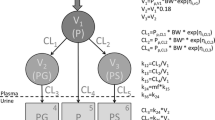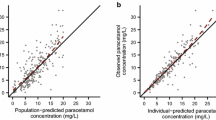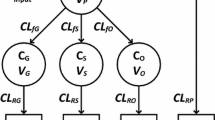Summary
In 14 neonates 1–4 weeks old, 30 babies aged 1–12 months, and 7 infants of 1–5 years of age, the serum levels of phenobarbital were determined by a gas chromatographic micro-method after intravenous injection of phenobarbital 5–10 mg per kg body weight. It was possible to calculate the pharmacokinetic parameters using a two compartment open model. The distribution volumes within the individual age groups and the rate constants k12 and k21 showed no significant differences, but the elimination half-life was significantly longer in neonates (118.6±16.1 h) than in babies (62.9±5.2 h) or infants (68.5±3.2 h).
Similar content being viewed by others
References
Luos, P.: Plasma levels and urinary excretion of three barbituric acids after oral administration to man. Acta pharmacol. (Kbh.)10, 147–165 (1954)
Butler, T. C., Mahaffee, C., Waddell, W. J.: Phenobarbital: Studies of elimination, accumulation, tolerance and dosage schedules. J. Pharmacol. exp. Ther.111, 425–435 (1954)
Svensmark, O., Buchthal, F.: Accumulation of phenobarbital in man. Epilepsia4, 199–206 (1963)
Bloomer, H. A.: A critical evaluation of diuresis in the treatment of barbiturate intoxication. J. Lab. clin. Med.67, 898–905 (1966)
Gladtke, E., Heimann, G.: The rate of development of elimination functions in kidney and liver of young infants. In: Basic and Therapeutic Aspects of Perinatal Pharmacology, (ed. by P. Morselli, S. Garattini and F. Sereni) pp. 393–403. New York: Raven Press 1975
Melchior, J. C., Svensmark, O., Trolle, D.: Placental transfer of phenobarbitone in epileptic women, and elimination in newborns. Lancet1967 II, 860–861
Ihle, W., Eggert, W., Grauel, E. L., Weh, L., Syllm-Rapoport, I.: Intravenöse Belastung mit Pheno- und Hexo-barbital bei reifen und unreifen Neugeborenen und jungen Säuglingen. Pädiatr. Grenzgeb.13, 351–364 (1974)
Heinze, E., Kampffmeyer, H. G.: Biological half-life of phenobarbital in human babies. Klin. Wschr.49, 1146–1147 (1971)
Garrettson, L. K., Dayton, P. G.: Disappearance of phenobarbital and diphenylhydantion from serum of children. Clin. Pharmacol. Ther.11, 674–679 (1970)
Claisen, L., Eisleb, O.: Liebigs Ann. Chem.401, 29 (1913)
Dünges, W., Bergheim-Irgs, E.: A new methylation method for the gas chromatography of barbituric acid. Analyt. Lett.6, 185–195 (1973)
von Hattingberg, H. M., Brockmeier, D., Kreuter, G.: A rotating iterative procedure (RIP) for estimating hybrid constants in multi-compartment analysis on desk computers. Europ. J. clin. Pharm.11, 381–388 (1977)
Breimer, D. D., Honhoff, C., Zilly, W., Richter, E., van Rossum, I. M.: Pharmacokinetics of hexobarbital in man after intravenous infusion. J. Pharmacokin. Biopharm.3, 1–11 (1975)
Butler, T. C.: Metabolic oxydation of phenobarbital to phydroxy-phenobarbital. Science120, 494 (1954)
Schmidt, G.: Der intravitale und postmortale Abbau von Barbituraten. Arch. Toxicol.17, 93–150 (1958)
Dost, F. H.: Grundlagen der Pharmakokinetik, 2. Ed. Stuttgart: Georg Thieme Verlag 1968
Wagner, J. G., Northam, J. I.: Estimation of distribution and half-life of a compound after rapid intravenous injection. J. Pharm. Sci.56, 529–531 (1967)
Riegelmann, S., Loo, J. C. K., Rowland, M.: Shortcomings in pharmacokinetic analysis by conceiving the body to exhibit properties of a single compartment. J. Pharm. Sci.57, 117–123 (1968)
Gibaldi, M., Nagashima, R., Levy, G.: Relationship between drug concentration in plasma or serum and amount of drug in the body. J. Pharm. Sci.58, 193–197 (1969)
Friis-Hansen, B.: Changes in body water compartments during growth. Acta paediat. scand. Suppl.110, 1 (1956)
Remmer, H., Siegert, M.: Kumulation und Elimination von Phenobarbital. Arch. exp. Path. (D.)243, 479–494 (1962)
Borèus, L. O., Jalling, B., Kållberg, N.: Clinical pharmacology of phenobarbital in the neonatal period. In: Basic and Therapeutic Aspects of Perinatal Pharmacology. (Ed. P. Morselli, S. Garattini and F. Sereni) pp. 331–340. New York: Raven Press 1975
Gladtke, E.: Der Thiosulfatraum des Kindes. 54. Beiheft zum Arch. Kinderheilk. Stuttgart: Ferdinand Enke Verlag 1966
Hungerland, H.: In: Linneweh, F. Die physiologische Entwicklung des Kindes. p. 217. Berlin-Göttingen-Heidelberg: Springer Verlag 1959
von Harnack, G. A., Hoffmann, S. O.: Klinisch experimentelle Untersuchungen zur Arzneimitteldosierung im Kindesalter. Arch. Kinderheilk.170, 213–221 (1964)
Eckstein, A., Romninger, E.: Über Schlafmittel im Säuglingsalter und ihre Wirkung auf die Atmung. Arch. Kinderheilk.70, 102 (1922)
Kazerowa, M.: Klinische Untersuchungen über Evipan als Schlafmittel bei Säuglingen und Kindern. Mschr. Kinderheilk.73, 406–412 (1938)
Buchthal, F., Lennox-Buchthal, M. A.: Phenobarbital. Relation of serum concentration to control of seizures. In: (ed. Woodbury D. M., Penry J. K. and Schmidt R. P.), Antiepileptic Drugs, p. 335–343. New York, North Holland, Amsterdam: Raven Press 1972
Jalling, B.: Plasma concentrations of phenobarbital in the treatment of seizures in newborns. Acta paediatr. scand.64, 514–524 (1975)
Wallin, A., Jalling, B., Boréus, L. O.: Plasma concentrations of phenobarbital in the neonate during prophylaxis for neonatal hyperbilirubinemia. J. Pediat.85, 392–397 (1974)
Jalling, B.: Plasma and cerebrospinal fluid concentrations of phenobarbital in infants given single doses. Dev. Med. Child. Neurol.16, 781–793 (1974)
Brachet-Liermain, A., Goutieres, F., Aicardi, J.: Absorption of phenobarbital after the intramuscular administration of single doses in infants. J. Pediat.87, 624–626 (1975)
Author information
Authors and Affiliations
Rights and permissions
About this article
Cite this article
Heimann, G., Gladtke, E. Pharmacokinetics of phenobarbital in childhood. Eur J Clin Pharmacol 12, 305–310 (1977). https://doi.org/10.1007/BF00607431
Received:
Revised:
Accepted:
Issue Date:
DOI: https://doi.org/10.1007/BF00607431




